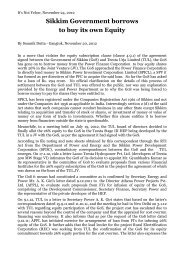Socio-Cultural Environment - Affected Citizens of Teesta (ACT)
Socio-Cultural Environment - Affected Citizens of Teesta (ACT)
Socio-Cultural Environment - Affected Citizens of Teesta (ACT)
You also want an ePaper? Increase the reach of your titles
YUMPU automatically turns print PDFs into web optimized ePapers that Google loves.
Lepchas and Tsongs, Bhutias and a very large number <strong>of</strong> migrant<br />
Nepalese. At present the Nepalese form the single largest ethnic<br />
community in the district. Characteristically, the comparatively high<br />
altitude areas in the northern part <strong>of</strong> the district, especially in Ravong<br />
sub-division, have dominance <strong>of</strong> Bhutias while the Nepalese inhabit the<br />
lower valley areas, mostly in Namchi sub-division. The Lepchas and the<br />
Tsongs are distributed in both the sub-divisions, usually within 2000 m<br />
elevations. The names <strong>of</strong> the prominent landmarks, streams and<br />
revenue blocks in the two sub-divisions are suggestive <strong>of</strong> the dominance<br />
<strong>of</strong> a particular ethnic community in a particular locality. In Ravong sub-<br />
division, almost all the peaks, rivers and revenue blocks bear Lepcha or<br />
Bhutia names. Mount Tendong and Menam, the two most revered peaks<br />
<strong>of</strong> the district are named by the Lepchas while the important places like<br />
Ravongla, Namchi, Kewzing, etc. are named by the Bhutias. On the other<br />
hand such names as Jaubari, Kerabari, Suntaley, Salgarhi,<br />
Chisopani, Shyampani, Rateypani, Manpur, Kartickey, Kamarey,<br />
Panchgharey, etc. in Namchi sub-division give clear indication <strong>of</strong> Nepali<br />
dominance in those areas. The diversity <strong>of</strong> individual ethnic groups is<br />
manifested by their religious practices, social norms, community<br />
behaviours, cultural activities and festivals, which will be discussed in<br />
following sections.<br />
3.2 RELIGION AND CULTURE<br />
The tribes and communities living in the district follow Buddhism,<br />
Hinduism and Christianity. Besides, a section <strong>of</strong> indigenous Lepchas<br />
and Tsongs practice nature worship (Animism, Yumaism) and a small<br />
20<br />
CISMHE




